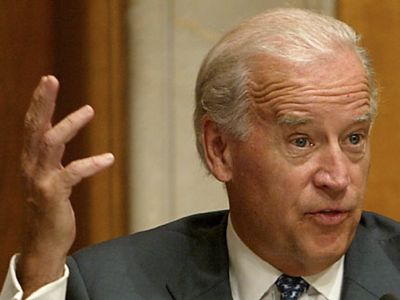
A Comprehensive Nuclear Arms Strategy
The administration’s Nuclear Posture Review outlines the means to achieve greater security from worldwide nuclear dangers. Nonproliferation and counter-terrorism are central to the strategy.
When I joined the Senate in 1973, crafting nuclear policy meant mastering arcane issues like nuclear stability and deterrence theory. With the end of the Cold War and a new relationship between our country and Russia, thankfully these subjects no longer dominate public discourse. Today, the danger of deliberate, global nuclear war has all but disappeared, but the nuclear threats we face from terrorists and non-nuclear states seeking to acquire such weapons are graver than ever.
On Tuesday, President Obama took an important step toward addressing these threats by releasing a plan that will reduce the role of nuclear weapons in our national security strategy while ensuring that our nuclear arsenal remains safe, secure and effective for as long as it is needed. The Nuclear Posture Review outlines a strategy, supported unanimously by the national security cabinet, for greater security from nuclear dangers and implements the agenda that President Obama first outlined in Prague just over a year ago to prevent the spread of nuclear weapons and to pursue the peace and security of a world without them.
This new strategy, a sharp departure from previous Nuclear Posture Reviews released in 2001 and 1994, leaves Cold War thinking behind. It recognizes that the greatest threat to U.S. and global security is no longer a nuclear exchange between nations, but nuclear terrorism by extremists and the spread of nuclear weapons to an increasing number of states. From now on, decisions about the number of weapons we have and how they are deployed will take nonproliferation and counter-terrorism into account, rather than being solely based on the objective of stable deterrence.
The review contains a clear rationale for the reductions called for under the New START treaty — a 30% reduction from the previous agreement. Because of advances in conventional capabilities and technologies such as missile defense, we need fewer nuclear weapons to deter adversaries and protect our allies than we did even a decade ago. Under the new review, we will retain only those weapons needed for our core requirements.
The plan also establishes a policy that the United States will not use or threaten to use nuclear weapons against non-nuclear states, as long as they are party to the Nuclear Nonproliferation Treaty and in compliance with their nuclear nonproliferation obligations. This approach provides additional incentive for countries to fully comply with nonproliferation norms. Those that do not will be more isolated and less secure.
The completion of a Nuclear Posture Review that is grounded in a commitment to American security will better protect us and our allies from nuclear threats. So will the signing of the New START treaty Thursday. And the unprecedented Nuclear Security Summit the president will host next week — with its focus on securing vulnerable nuclear materials around the world in four years — will advance these goals still further.
At the same time, the president is determined to ensure that our nuclear weapons remain absolutely safe, secure and effective. That is why he has asked Congress to increase funding for our nuclear complex by $5 billion over the next five years, allowing us to upgrade aging facilities and recruit and retain the highly skilled scientists and engineers needed to sustain our arsenal. Our plan reverses a decade-long erosion in support for the national laboratories. This commitment will ensure that our arsenal remains ready.
We can achieve these objectives while upholding this country’s nearly two-decade moratorium on nuclear tests and continuing our efforts to ratify the Comprehensive Nuclear Test Ban Treaty. And although we will not develop new warheads or add military capabilities as we manage our arsenal for the future, we will pursue needed life-extension programs so the weapons we retain can be sustained. This approach has broad support, and, as Defense Secretary Robert Gates states in his preface to the Nuclear Posture Review, it is a "credible modernization plan necessary to sustain the nuclear infrastructure and support our nation’s deterrent."
The president and I made a promise to the American people to protect them from nuclear risks. We have no higher obligation. Our strategy delivers on that promise and tackles the most immediate threats our planet faces.
– Treaty between USA and Russia on measures for the further reduction and limitation of strategic offensive arms (April 8, 2010)
– START: Op-Ed by Hillary Clinton: « Our Giant Step Towards a World Free from Nuclear Danger » (April 7, 2010)
– START: Op-Ed by Vice President Joe Biden: « A Comprehensive Nuclear Arms Strategy » (April 7, 2010)
– START: press point by Sergey Lavrov (April 6, 2010)
– Statement by Barack Obama on the Release of Nuclear Posture Review (April 6, 2010)
– Remarks of Joe Biden at National Defense University (February 18, 2010)
– Speech by Barack Obama dealing with nuclear issues (April 5, 2009)

 Articles by this author
Articles by this author















Stay In Touch
Follow us on social networks
Subscribe to weekly newsletter